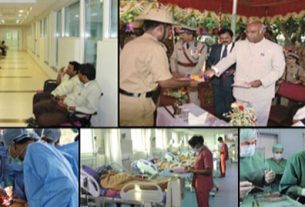Healthcare system in India needs a major push especially during the time of a pandemic when there is a shortage of nurses and other health professionals.
Jaipur: On the day the United States celebrates nurses, India is acutely feeling the need for more nurses.
India is set to face the biggest shortage of nurses in the world after Bangladesh, according to the World Health Organization (WHO), as many more health workers may have migrated abroad or have retired than government data suggests. There are just 1.7 nurses per 1,000 people in India, according to the Union health ministry. That’s far less than the WHO’s prescribed minimum of three. In March 2021, the government told the Rajya Sabha that India has 3.07 million registered nursing personnel, including nurses, midwives and nursing assistants.
The shortage of trained nurses is dire, with a nurse-to-population ratio of 1:670 against the WHO norm of 1:300. There is also a significant shortage of all categories of health workers in government health facilities. Seats in medical colleges are highly skewed across states, with two-thirds of all MBBS seats in the country concentrated in seven states (Tamil Nadu, Kerala, Andhra Pradesh, Telangana, Karnataka, Maharashtra and Gujarat) according to the 15th Finance Commission.
Anjali Sharma, a Nurse working at AIIMS Patna said “I am working in Covid wards. It has been very hectic during this time. In the Covid ward, facilities like the ventilators and intubates are not always available. There is a lack of equipment.”
“It has been so emotionally draining. I felt very helpless when patients died or were in critical situations. A 28-year-old lady died only because there was no ventilator available. She didn’t even have any comorbidities. This is when we feel hopeless. I have had sleepless nights because of the situation that persists. Most of the staff members are Covid positive at our hospital and there is a shortage of staff members here,” added Anjali .
Sanika*, a Nurse from AIIMS Patna said “The ratio of nurses to patients is not adequate. Nurses have to look at more patients at a time. Here there is a shortage of staff. So it becomes difficult to manage so much. We are not given any facilities.”
India has around 8692 nursing colleges in India. The problem is not just with the shortage of nurses but also how the distribution is skewed. In the country, the overall nurse to patient ratio is 1:7. However the problem is that in some areas the ratio is high, and in the other low. The ratio varies from state to state, district to district, and institution to institution.
Hitesh Gauttam, a professor from G.L. Saini Memorial College of Nursing said “We need to improve the number of health professionals that exist in India. They should be given proper skill training. The ratio at college is 80:20. The ratio of boys to girls is uneven. Girls are fewer in number.”
India has emerged as the largest exporter of doctors and nurses to European countries, according to a report. Personal and home health aides, registered nurses, and medical and nursing assistants are among the fastest growing occupations in the United States. The U.S. Bureau of Labor Statistics projects 1.2 million new personal and home health aide positions – and the need for another 372,000 registered nurses – by 2028. Due to the shortage of qualified healthcare workers, immigrants held 15 percent of all registered nursing positions in the United States in 2016.
India has the world’s highest number of medical schools and is the world’s largest source of immigrant physicians. An estimated 69,000 Indian-trained physicians worked in the United States, UK, Canada and Australia in 2017, according to the OECD. India is second only to the Philippines in training nurses. Nearly 56,000 Indian-trained nurses work in those same four countries, equal to about three percent of total registered nurses in India.
What are the possible solutions?
Dr. Sylvia Karpagam, Public Health Expert said “Even before the pandemic the health infrastructure was bad in India. There was very little focus on public health. There was a Tendency of a very centralized, corporate centric, private sector kind of a model. There is very little investment in the public health sector. With such a condition we were not really ready for a pandemic like situation in India.”
“One solution is to regulate the private health sector. We need a more standardized form of treatments. Many serious patients are being denied healthcare because of the absence of such a structure,” said Sylvia.
“There is a lack of representation of medical professionals from the rural areas. The doctors and nurses are mostly from an urban area. There should be more representation from different groups of gender, culture and religion. The medical training should be publicly funded in order to improve the ratio of doctors and nurses,” added Sylvia.
Chandrakant Lahariya, a Public Health Policy Strategist said “In the pandemic, we have observed a shortage of human resources, especially in the public health sector. There are job vacancies for health professionals that are going empty. There is a shortfall in government spending and a failure to retain talented professionals due to low salary structure.”
“A change in the government policy is needed to make it more conducive for health professionals in the government facilities. The government of India’s spending on health facilities and infrastructure is far less than many other countries in the world. India’s spending on health is 1.2 percent of the GDP and National Health Policy talks about 2.5 percent of the GDP.”
*indicates name change





This was heartbreaking to read.